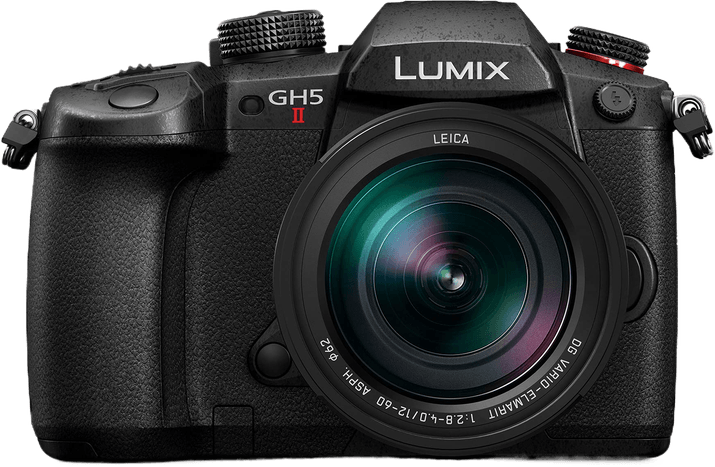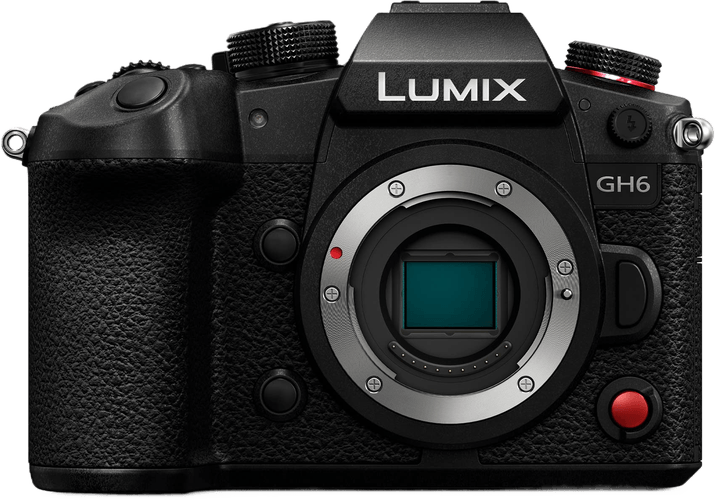Panasonic Lumix DC-GH5 II vs Lumix DC-GH6 Comparison
Panasonic Lumix DC-GH5 II

Panasonic Lumix DC-GH6

The Panasonic Lumix DC-GH5 II and the Panasonic Lumix DC-GH6 are both mirrorless cameras with a score of 73/100. These cameras share some common specifications, such as being released in 2021 and 2022, respectively, with launch prices of $1699 and $2199. They have similar dimensions, with the GH5 II measuring 139 x 98 x 87mm and the GH6 at 138 x 100 x 100mm.
The GH5 II has an advantage in terms of weight, being lighter at 727g compared to the GH6’s 823g. This makes it more portable and easier to handle during long shooting sessions. On the other hand, the GH6 offers some improvements over the GH5 II, which can justify its higher price point. However, specific details about these improvements are not provided in the given information.
Both cameras have their strengths and weaknesses, with the GH5 II being more lightweight and affordable, while the GH6 may offer better features at a higher cost. Ultimately, the choice between these two cameras depends on the individual’s priorities and budget.
Panasonic Lumix DC-GH5 II vs Lumix DC-GH6 Overview and Optics
The Panasonic Lumix DC-GH6 wins the optics comparison with a score of 69/100, just one point ahead of the Panasonic Lumix DC-GH5 II, which scores 68/100. Both cameras share several specifications, including a CMOS sensor, Venus Engine processor, Micro Four Thirds sensor size, Micro 4/3 lens mount, and image stabilization.
The GH6 has an advantage in terms of megapixels and shooting speed. With 25 megapixels, it captures more detail than the GH5 II, which has 20.33 megapixels. The GH6 also has a faster shooting speed of 14 frames per second compared to the GH5 II’s 12 frames per second. This makes the GH6 more suitable for capturing fast-moving subjects and high-resolution images.
However, the GH5 II has a higher DXOMARK score for its sensor, with a score of 79 compared to the GH6’s 71. This means that the GH5 II’s sensor performs better in terms of color depth, dynamic range, and low-light performance. This advantage may be essential for photographers who prioritize image quality and low-light shooting.
While the GH6 has a slight edge in terms of megapixels and shooting speed, the GH5 II’s superior sensor performance cannot be ignored. Both cameras are well-suited for different photography needs, with the GH6 excelling in capturing fast action and high-resolution images, and the GH5 II focusing on image quality and low-light performance. Ultimately, the choice between these two cameras will depend on the specific requirements of the photographer.
Panasonic Lumix DC-GH5 II vs Lumix DC-GH6 Video Performance
The Panasonic Lumix DC-GH6 outperforms the Panasonic Lumix DC-GH5 II in video capabilities, scoring 96/100 compared to the GH5 II’s 74/100. Both cameras share some common features, such as 6K max video resolution and built-in time-lapse functionality. However, there are key differences that make the GH6 the superior choice for videographers.
One major advantage of the GH6 is its higher max video dimensions of 5760 x 2880, compared to the GH5 II’s 4992 x 3774. This allows the GH6 to capture more detailed and higher resolution footage, providing better image quality for professional projects. Furthermore, the GH6 has a significantly higher max video frame rate of 120fps, while the GH5 II is limited to 30fps. The higher frame rate enables the GH6 to record smoother slow-motion footage, granting more creative freedom to filmmakers.
Although the GH5 II has a lower score in video capabilities, it still offers solid performance for those who do not require the extra features provided by the GH6. Its 6K max video resolution and built-in time-lapse functionality make it a suitable option for hobbyists or those on a tighter budget.
Taking these factors into account, it is clear that the Panasonic Lumix DC-GH6 is the superior camera in terms of video capabilities. Its higher max video dimensions and frame rate provide better image quality and creative flexibility, making it an ideal choice for professional videographers. On the other hand, the Panasonic Lumix DC-GH5 II remains a viable option for those with less demanding video needs or budget constraints.
Panasonic Lumix DC-GH5 II vs Lumix DC-GH6 Features and Benefits
The Panasonic Lumix DC-GH5 II wins the features comparison with a score of 85/100, while the Panasonic Lumix DC-GH6 scores slightly lower at 83/100. Both cameras share some common specifications, including a 3-inch touchscreen, flip screen, and the absence of GPS. Additionally, both cameras are equipped with WIFI and Bluetooth capabilities.
The Lumix DC-GH5 II outperforms the Lumix DC-GH6 in terms of screen resolution, boasting 1,840,000 dots compared to the GH6’s 1,240,000 dots. This difference results in a sharper and clearer display on the GH5 II, enhancing the user experience when composing shots, reviewing images, and navigating the camera’s menu.
On the other hand, the Lumix DC-GH6 still holds its ground despite its slightly lower score. The similarities in screen size, touchscreen, flip screen, and connectivity features make it a competent contender in the market. However, it is essential to consider that the GH6’s lower screen resolution may not provide the same level of detail and clarity as the GH5 II.
Taking into consideration the specifications and features of both cameras, the Panasonic Lumix DC-GH5 II emerges as the stronger option due to its superior screen resolution. The Lumix DC-GH6 is a viable choice for those who prioritize other features and can compromise on screen resolution. Ultimately, the decision between these two cameras depends on individual preferences and the specific requirements of the user.
Panasonic Lumix DC-GH5 II vs Lumix DC-GH6 Storage and Battery
The Panasonic Lumix DC-GH5 II outperforms the Panasonic Lumix DC-GH6 in storage and battery, scoring 71/100 compared to the GH6’s 68/100. Both cameras have two memory card slots and support USB charging. They also accept UHS-II compatible SD cards. However, the GH5 II has a slight edge with its battery life, offering 400 shots per charge, while the GH6 delivers 360 shots.
The GH6 does have an advantage in storage flexibility, as it also accepts CFexpress B cards in addition to SD cards. This allows for faster data transfer and larger storage capacities. Despite this advantage, the GH5 II’s longer battery life contributes to its superior score in this category.
Considering the storage and battery aspects, the GH5 II is the preferred choice for extended shooting sessions due to its longer battery life. However, the GH6 offers more storage options with the added compatibility of CFexpress B cards.
Panasonic Lumix DC-GH5 II vs Lumix DC-GH6 Alternatives
If you want to check out some more comparisons for inspiration, why not start with these:
